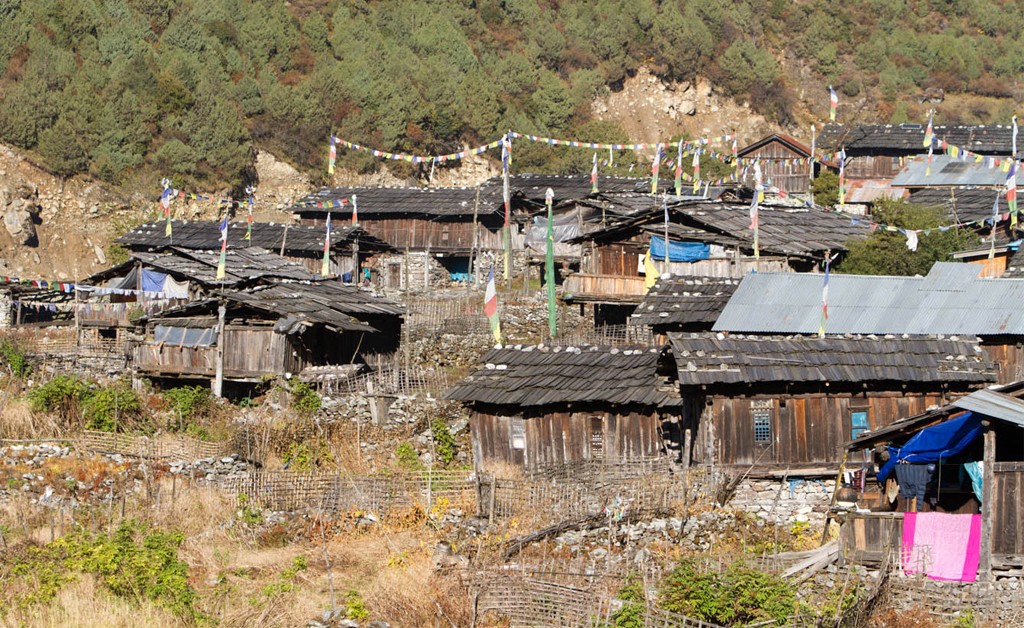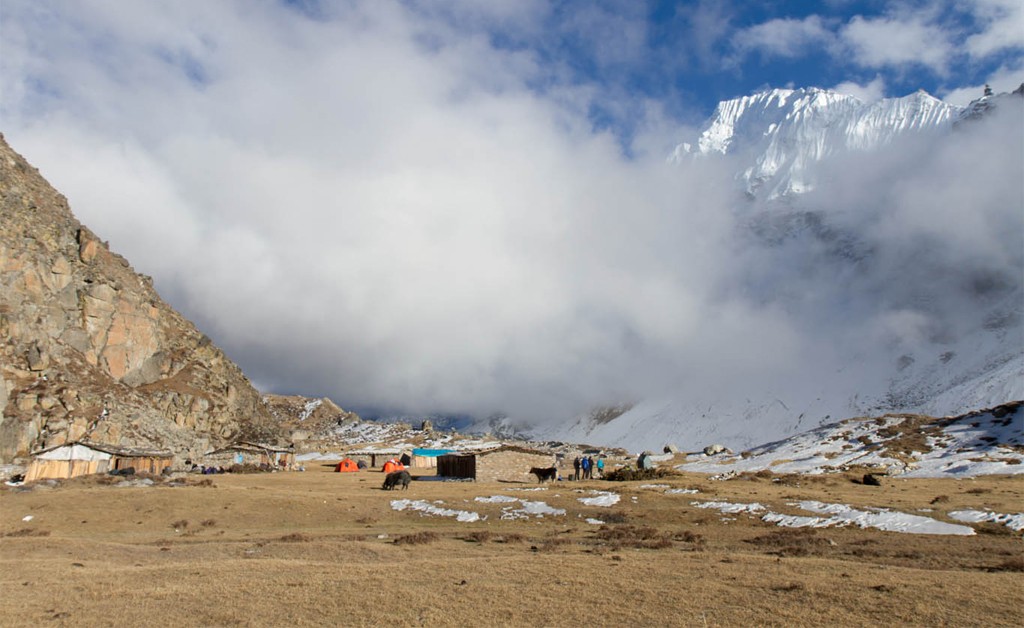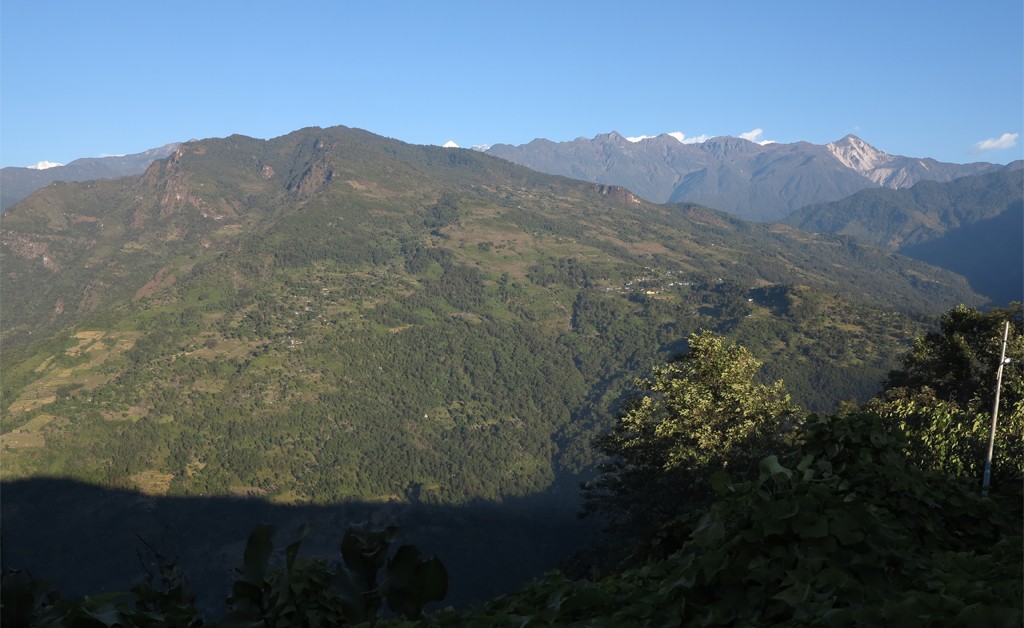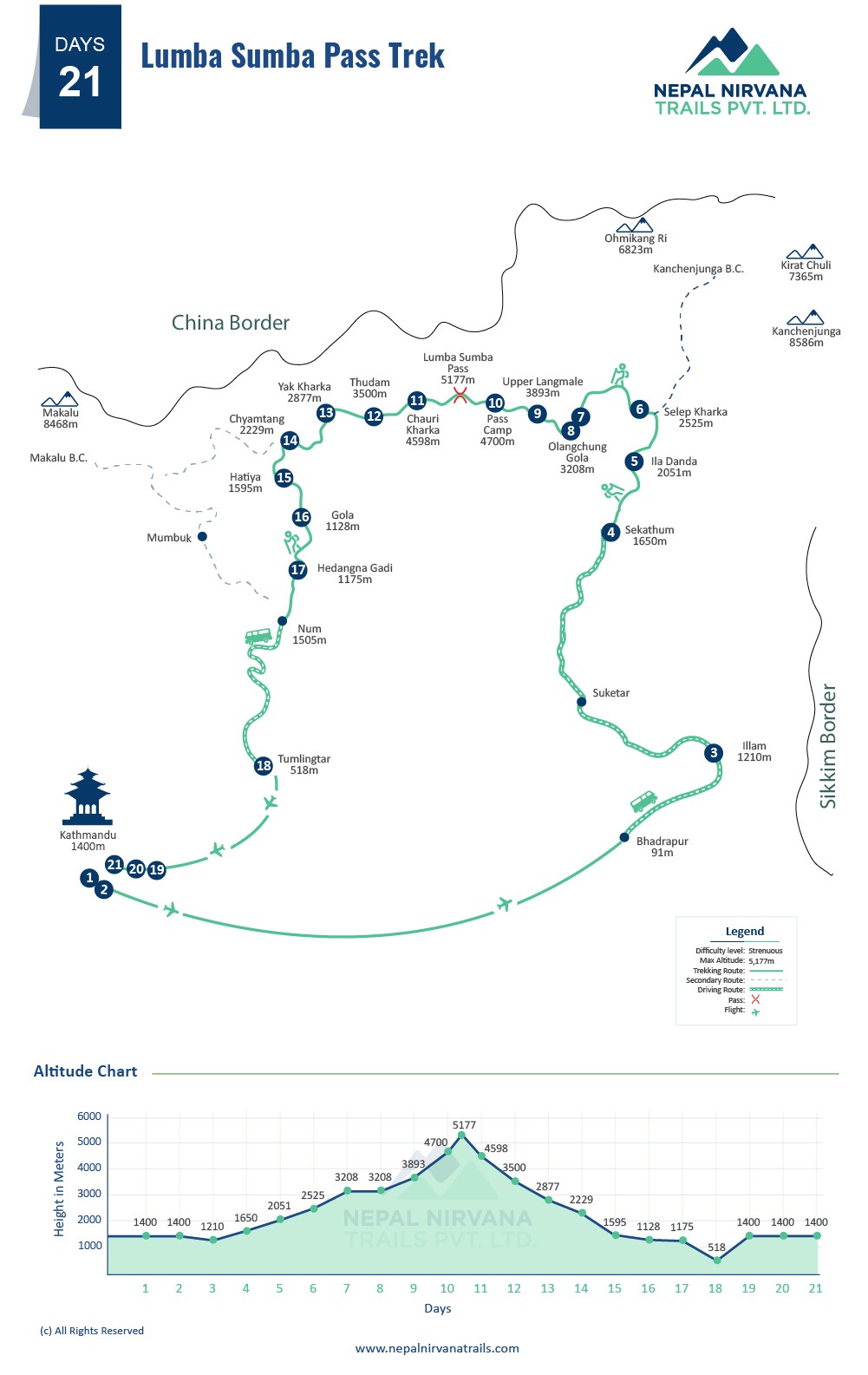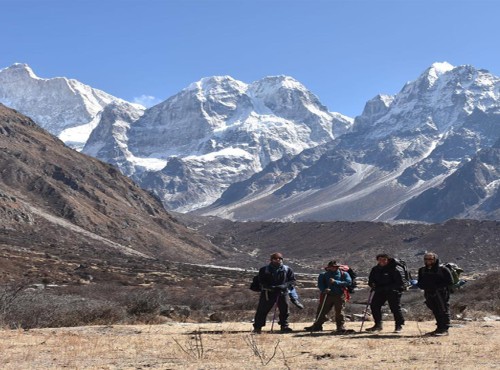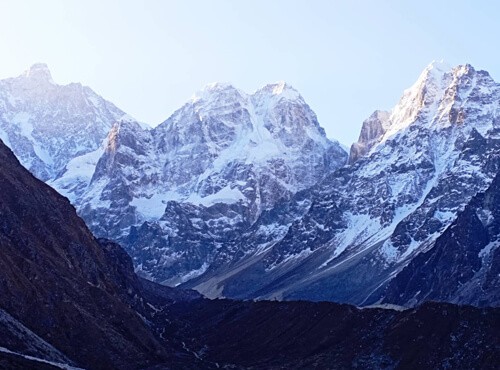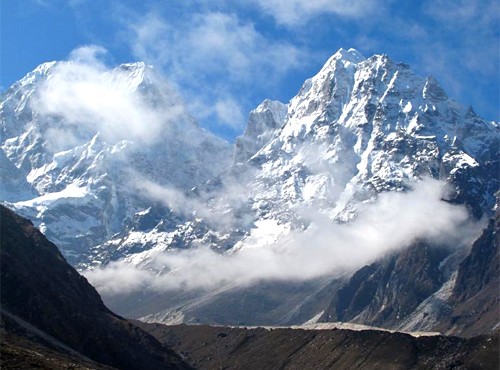The Lumba Sumba pass trek is one of Nepal's best-kept secrets. This trek explores the remote Kanchenjunga and Makalu regions in the eastern Himalayas of Nepal. It is a camping trek, so the trekkers have to be self-sufficient. This 21-day long trek is an ideal package for anyone looking for an untouched and unheard trekking route in the Himalayas.
We, Nepal Nirvana Trails provide full support during the Lumba Sumba Pass camping trek in Nepal. Our expert on-field team will make sure you are traveling safely and enjoying every moment in the mountains. We will take care of all the accommodation and meals during the trek, allowing you to fully immerse in the journey.
The Lumba Sumba pass trek was opened in 2012. The trail follows a section of the Great Himalayan Trail (GHT). The Lumba Sumba pass connects Kanchenjunga Conservation Area with Makalu Barun National Park. Because of no tourist infrastructure and offbeat terrain, only a handful of trekkers have explored this adventurous route.
Trekking from sub-tropical forests, the trail ascends to high grasslands and alpine zones. You will rarely see any fellow trekkers on the way. The highest point of the trek, Lumba Sumba Pass, is located at 5,177 meters (16,985 ft). Likewise, the Tamor and Arun river system is another highlight of Lumba Sumba pass trekking. As you trek from one zone to another, you will get to witness many different landscapes.
During the trek, you will pass via verdant valleys, rocky gorges, and beautiful villages. Limbus, Sherpas, Rais, Gurungs, Magars, and Tamangs are the major inhabitants along the Lumba Sumba pass trail. The locals are quite friendly and welcoming, like any other Himalayan trail. The Lumba Sumba Pass trek is equally rich in cultural heritage. There are many chortens, stupas, and prayer flags on the way. Likewise, the interactions with locals are one of the precious parts of the trek.
Mountain views and wildlife during the Lumba Sumba pass trek in Nepal
During the Lumba Sumba pass trek, you will get to see stunning views of the third-highest mountain in the world- Mount Kanchenjunga (8586m.|28169ft.) & the fifth-highest mountain in the world- Mount Makalu (8481m.|27825ft.). Similarly, you will see many other mountains like Sarphu Himal (6433m.|21105ft.), Sarphu II (6328m.|20761ft.), Sarphu III (6158m.|20203ft.), Nangma (5201m.|17063ft.), Marson (6220m.|20406ft.), Senup (6265m.|20554ft.), Ghanlung Himal (5757m.|18888ft.), etc. Likewise, around Olangchung Gola village (3208m.|10524ft.), there are many alpine lakes where you can unwind and rejuvenate.
As the Lumba Sumba pass trail winds through two highly protected areas in Nepal, you will get to see diverse species of flora and fauna. The rhododendron and pine forests, rushing rivers, and cascading waterfalls make the lower part of the trail bloom with various vegetation. The region is home to many wildlife and birds, including the exotic snow leopard and red panda.
Extend the Lumba Sumba pass trek to Kanchenjunga Base Camp and/or Makalu Base Camp
Usually, trekkers embarking on the Kanchenjunga Circuit Trek have the opportunity to discover the Kanchenjunga Base Camp, while those undertaking the Makalu Base Camp Trek can explore the Makalu Base Camp. As you are already touching these two regions on Lumba Sumba pass trek for 21 days, you can extend the trek to either or both base camps if you have a few extra days to travel.
To extend the Lumba Sumba pass trek to the Kanchenjunga base camp, you will need 6 more days. The trail separates from Hatiya. Below is the itinerary:
Day 01: Trek from Sekathum to Amjilosa (2498m.|8195ft.)
Day 02: Trek from Amjilosa to Ghunsa (3415m.|11205ft.)
Day 03: Trek from Ghunsa to Khambachen (4145m.|13599ft.)
Day 04: Trek from Khambachen to Kanchenjunga North Base Camp (5143m.|16873ft.) and return to Khambachen for a night stay
Day 05: Trek back to Ghunsa (3415m.|11205ft.)
Day 06: Trek to Sekathum (1650m.|5413ft.)
To extend the Lumba Sumba pass trek to Makalu base camp, you will need 12 more days. The trail separates from Hatiya. Below is the itinerary:
Day 01: Trek from Hatiya to Dhumjung (1680m.|5512ft.)
Day 02: Trek to Chamling Ma (2448m.|8031ft.)
Day 03: Trek to Bagare (2912m.|9554ft.)
Day 04: Trek to Nehe Kharka (3770m.|12368ft.)
Day 05: Trek to Langmale Kharka (4510m.|14796ft.)
Day 06: Trek to Makalu BC (4870m.|15977ft.)
Day 07: Rest day at Makalu Base Camp
Day 08: Trek to Yangla Kharka (3610m.|11843ft.)
Day 09: Trek to Dobate (3550m.|11646ft.)
Day 10: Trek to Khongma (3562m.|11686ft.)
Day 11: Trek to Tashi Goan (2100m.|6889ft.)
Day 12: Trek to Seduwa (1530m.|5019ft.)
Lumba Sumba pass trek difficulty
The Lumba Sumba pass trek is one of the most strenuous treks in Nepal. The off-the-beaten-path, unpredictable weather, long walking hours, and high altitude make this trek quite challenging. The path of the Lumba Sumba pass trek takes adventurers through the distant and secluded areas of the Kanchenjunga and Makalu regions. The trekking route involves long steep ascents and descents. The trail is mostly rugged and uneven.
Each day, you will cover 9 to 11 kilometers (5 to 7 miles), which means a minimum of 6 hours of walking. Similarly, the challenges are compounded by the remote nature of the area and the absence of tourist infrastructure. You will be exploring the rural communities, so you cannot expect any modern facilities. You not only have to be well prepared for this trek physically and mentally, but proper packing is also important.
Altitude sickness during the Lumba Sumba Pass trek
The Lumba Sumba Pass trek starts from Sekathum (1650m.|5413ft.) and ascends to the top of the Lumba Sumba Pass at 5,177 meters (16,985ft.). Due to the significant gain in altitude, the trek carries the potential for altitude sickness. However, this trek does not see any sudden drastic change in elevation, and you will get ample time to adjust to the elevation before trekking beyond 5,000 meters (1,6404ft.).
By adopting preventive measures and being aware of altitude sickness symptoms, you can avoid altitude sickness altogether on this trek. These are a few symptoms of altitude sickness- headache, difficulty in breathing, insomnia, vomiting, loss of appetite, etc. Keep yourself hydrated while trekking & take proper rest and have plenty of food to avoid altitude sickness.
Our Lumba Sumba pass trek itinerary has adequate acclimatization days to let you rest and recover as your trek further. In case you observe any of these symptoms, make sure to inform your guide right away. Our guides have received proper training to manage medical emergencies in mountainous settings, ensuring that you are in capable and secure hands.
Can I do the Lumba Sumba Pass trek as a beginner trekker?
We do not recommend Lumba Sumba pass trek of 21 days to individuals who are trekking for the first time. This trek is very demanding in all manners. However, if you are an active and fit person with high-altitude experience, you can do this trek with us. Do note that this trek comes with many limitations, so your endurance matters a lot too. Why don't you talk with us once? We will assess your fitness and customize the trek to suit you the best.
Alternative untouched trekking routes in Nepal
Nepal has many untouched trekking routes like the Lumba Sumba Pass camping trek. Some of them are- Rupina La pass trek, Sherpani Col pass trek, Upper Dolpo trek, Rolwaling valley trek, Manaslu Tsum valley trek, Nar Phu valley trek, etc.
You can customize any trek with us, including the Lumba Sumba Pass trek, as per your necessities. For more information, you can use this mail address to write to us- [email protected] or call/text us at +977 9841380469.
Lumba Sumba pass trek cost
We have the best price for the Lumba Sumba Pass camping trek. If you are a single traveler, the cost starts at USD 6,600 per head. Likewise, for two trekkers, you can do this trek for USD 4,030 per person. In a group of 3 to 4 trekkers, the Lumba Sumba Pass trek cost ranges between USD 3,900 to USD 3,600. We provide more discounts for bigger groups.
All these prices are inclusive of permits, taxes, and the company's service charge. Join us on our Lumba Sumba Pass Trek 2025/2026/2027 departures. Book the trip early for additional offers.
